This page provides a step-by-step description of how to enter summary information on municipal solid waste (MSW) landfills as required by Subpart HH of the Greenhouse Gas Reporting Program.
Adding or Updating
...
Landfill Details for this Facility
...
{composition-setup}{| Composition Setup |
|---|
} |
|---|
|
| Wiki Markup |
|---|
{
:=} Click image this link to expand 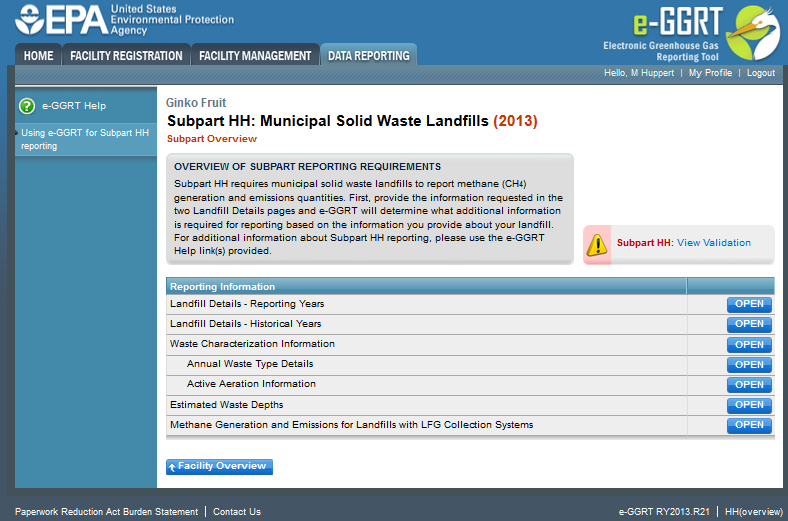 Image Removed
Image Removed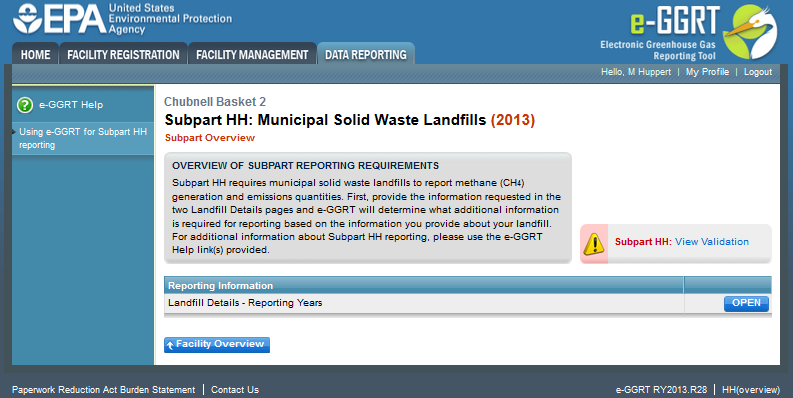 Image Added
Image Added
| Cloak |
|---|
| Wiki Markup |
|---|
{cloak:id=PNG1|| cloak.toggle.zone | true |
|---|
| id | PNG1 |
|---|
| | =none|cloak.toggle.zone=true}
| Panel |
|---|
 Image Removed Image Removed
|
To begin data entry for your current year reportTo add or modify Subpart HH reporting years summary information for this MSW landfill, press the OPEN button located opposite “Landfill Details - Reporting Years.”
Landfill Details - Reporting Years
"Landfill Details - Reporting Years" must be populated before other information about the landfill and its emissions can be entered. Reporting years start with the first year emissions reporting was required under Part 98 (i.e., 2010 and later).
| Wiki Markup |
|---|
{
:=} Click image this link to expand  Image Removed
Image Removed Image Added
Image Added
| Cloak |
|---|
| Wiki Markup |
|---|
{cloak:id=PNG2|| cloak.toggle.zone | true |
|---|
| id | PNG2 |
|---|
| | =none|cloak.toggle.zone=true}
| Panel |
|---|
 Image Removed Image Removed
|
| Excerpt |
|---|
The following MSW landfill information is collected for Subpart HH |
...
on the Landfill Details - Reporting Years page - An indication of whether the landfill was open or closed in
|
...
- the reporting year. A landfill is considered open if it is actively receiving waste in the reporting year. A landfill that closed during the reporting year, but also received waste during the reporting year is considered open for the particular reporting year. A landfill is considered closed if it did not receive waste in the reporting year.
|
...
- Indicate the year in which the landfill first started accepting waste for disposal.
- If the landfill was open in
|
...
- the reporting year, indicate the year in which the landfill is expected to close.
- If the landfill was closed prior to and not during
|
...
- the reporting year, indicate the last year that the landfill accepted waste.
Waste Disposal Quantities and |
...
Methods Since the First year of ReportingThe reporter is then shown the first year of emissions reporting that occurred under Part 98 for the facility (i.e., 2010, 2011, 2012 or 2013). |
...
...
during any reporting years, the method(s) used to determine the quantity of waste received at the landfill |
...
...
reporting year(s) must be indicated for loads other than cars, light duty trucks, and loads that cannot be measured with scales due to physical or operational limitations. Choose from one of the following methods (from §98.343(a)(3)) by checking the appropriate box: - Used scales to weigh each load before off-loading at the landfill and either used scales to weigh individual loads after off-loading or used a representative tare weight for the weight of the vehicle/container after off-loading at the landfill. According to §98.343(a)(3)(i)(B), the tare weight is determined by weighing no less than five of each type of vehicle or container after it has off-loaded the waste.
- Used vehicle/container working capacity, for example by using volumetric capacity and waste density measurements, for each container/vehicle used to haul waste to the landfill (§98.343(a)(3)(ii)). The working capacity means the maximum volume of mass of waste that is actually placed in the landfill from an individual or representative container (such as a tank, truck, or roll-off bin) used to convey wastes to the landfill, taking into account that the container may not be able to be 100 percent filled and/or 100 percent emptied for each load.
Note that the "Other" method was only available for the 2010 reporting year and only for facilities that were approved by EPA to use Best Available Monitoring Methods (BAMM). | Note |
|---|
Per §98.343(a)(3), beginning in the first emissions reporting year, and each year thereafter, waste quantities must be determined using one of the methods listed above. If scales are in place at the landfill, they must be used to determine waste quantities for the first emissions reporting year and each year after |
|
...
Additionally, the total annual waste disposal quantity(ies) in metric tons must be reported for each year and method. If you reported or resubmitted prior to the current reporting year, the methods and waste disposal quantity(ies) from prior years will be automatically populated and you will only need to enter data for the current reporting year. It is recommended that you review all automatically populated data to ensure its continued accuracy. |
Facilities that reported to the program in prior years will see the data they previously entered since the first year of reporting. This data has been carried over from previous reports. Reporters should check the accuracy of this data, make any needed changes, and add the data for the current reporting year. Note that the screenshot below illustrates an example reporter who started reporting in 2010 and entered waste quantities and methods for the 2010, 2011, and 2012 years. This facility must check the data and then add their methods and waste quantities for the 2013 reporting year.
Click this link to expand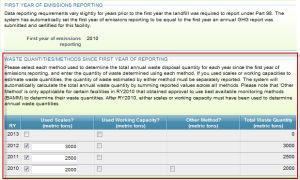 Image Added
Image Added
| Cloak |
|---|
| cloak.toggle.zone | true |
|---|
| id | PNG7 |
|---|
| cloak.toggle.type | none |
|---|
|
| |
| Wiki Markup |
|---|
{toggle-cloak:id=PNG7} |
Click image to expand  Image Removed
Image Removed| Wiki Markup |
|---|
{cloak:id=PNG7|cloak.toggle.type=none|cloak.toggle.zone=true} |
| Panel |
|---|
 Image Removed Image Removed
|
If you changed methods used for determining the waste disposal quantities during the reporting year, answer the question above by reporting the method used at the end of the reporting you may check the box for more than one method in a year. In addition, provide an explanation as to why you changed methods , for example, scales were installed at your facility mid-year. Please provide this explanation in the Subpart A text box that requests an explanation of changes to calculation methodologies (e.g., scales were installed at your facility mid-year).
After entering information on waste disposal quantities and methods, enter the landfill capacity in metric tons.
...
Indicate if leachate recirculation is used at the landfill during the emissions reporting year (check the box if leachate recirculation is was used).
If leachate recirculation is used, indicate Indicate the typical frequency with which it is leachate recirculation was used over the past 10 years. Choose one of the following:
- Used several times a year for the past 10 years
- Used at least once a year for the past 10 years
- Used occasionally (but not every year) over the past 10 years
- Not used for the past 10 years
Indicate if scales are present at the landfill in the reporting year (check box if scales are present). If you check the box that you used scales to determine waste quantities during the reporting years and your landfill is still open, this box should be checked indicating that scales are present at the facility.
Cover Materials
Identify each type of cover material in use at the landfill . Indicate the surface area of the landfill containing waste in square meters associated with the following types of cover material (more than one type of cover may be selected):
- Organic
- Clay
- Sand
- Other soil mixture (this should be selected for any cover type other than organic, clay, or sand)
Then enter the total the surface area of the landfill containing waste.
Fraction of Methane in Landfill Gas and Methane Correction Factor
Starting in reporting year (RY) RY2013, the Fraction of Methane in Landfill Gas (F) and Methane Correction Factor (MCF) is collected once on the Landfill Details - Reporting Years page and is applied to all reporting years. For RY2010 through RY2012 these data are collected with the waste characterization data for each year. These reporting requirements include the following:
- Indicate if the fraction of CH4 in the landfill gas (F) is based on a measured value or the default value of 0.5. (Check the box if the default value was not used.) The default value of 0.5 will automatically populate the data field unless the box above is checked. If the box is checked, a value for F, other than 0.5, must be entered in the data field.
- Indicate if the Methane Correction Factor (MCF) other than the default of 1 was used. (Check the box if the default value was not used.) An MCF value other than the default may only be used if active aeration is in use at your landfill, in which case you must enter information about the aeration system. The default value of 1.0 will automatically populate the data field unless the box above is checked. If the box is checked, a value for MCF, other than 1.0, must be entered in the data field. If you report a MCF other than 1 a link to the Active Aeration Information page will appear on the Subpart Overview screen where you will be asked to provide additional detail on the basis for this selection.
Landfill Gas Collection System
A landfill gas collection system means is defined as a system of pipes used to collect landfill gas from different locations in the landfill by means of a fan or similar mechanical draft equipment to a single location for treatment or use. A single landfill may have multiple gas collection systems. Landfill gas collection systems do not include “passive” systems, whereby landfill gas flows naturally to the surface of the landfill where an opening or pipe (vent) is installed to allow for natural gas flow.
Indicate if the landfill has a gas collection system on the "Landfill Details - Reporting YearYears" page (check the box if there is a gas collection system).
If the landfill has a landfill gas collection system, indicate provide the following information:
- The manufacturer of the gas collection system
...
- .
- The capacity of the system in actual cubic feet per minute (acfm)
...
- .
- The number of wells present at the landfill
...
- .
- The annual operating hours for the system.
For manufacturer of the gas collection system, indicate the entity that designed the gas collection system and the entity that installed the gas collection system. If this information is not available, report the manufacturer of the blower. Do not use this space to indicate the manufacturer of the flares in the place at the landfill. Also do not use this space to indicate the brand of measurement equipment used to monitor landfill gas flow or methane concentration.
...
Landfill Details - Historical Years
To add or modify Subpart HH historical years summary information for this MSW landfill, press the OPEN button located opposite “Landfill Details - Historical Years.”
| Wiki Markup |
|---|
{composition-setup}{composition-setup} |
unmigrated-inline-wiki-markup
{
:=} Click image this link to expand  Image Removed
Image Removed Image Added
Image Added
| Cloak |
|---|
|
| Wiki Markup |
|---|
{cloak:id=PNG10|cloak | type=none|cloak.toggle.zone=true}
| Panel |
|---|
 Image Removed Image Removed
|
| zone | true |
|---|
| id | PNG10 |
|---|
| cloak.toggle.type | none |
|---|
|
| |
If you reported prior to RY2012, the historical waste disposal quantity methods should be automatically populated in the "Landfill Details Historical Years" page, and you will only need to enter data for RY 2012 based on the instructions below. For more on the historical migration of data, see Carry forward of data from previous submissions into RY2012 forms. There are several means by which the quantities of waste disposed of prior to 2012 the first year of reporting may have been determined or estimated for purposes of the Greenhouse Gas Reporting Program: (1) determined using scales; (2) estimated
- Determined using scales.
- Determined from working capacities
- Estimated from tipping receipts, other company records, or measured working capacities
...
- .
- Estimated from one of the methods found in Section 98.343(a)(4)
...
- (i.e., methods #1, 2, and 3 listed below).
Reporters must indicate which method(s) was used to determine or estimate historical waste disposal quantities and the range of years in which that method was used.
Indicate (yes/no) if scales were used to determine waste disposal quantities for loads other than cars, light duty trucks, and loads that cannot be measured with scales due to physical or operational limitations prior to 2012the first emissions reporting year.
If scales were used, indicate the first year they were used (i.e., start year) and the last year they were used (i.e., end year).
Indicate (yes/no) if working capacities were used to determine waste disposal quantities prior to the first emissions reporting year.
If working capacities were used, indicate the first year they started being used were used (i.e., start year) and the last year they stopped being were used (i.e., end year).
Indicate (yes/no) if tipping receipts , or other company records , or measured working capacities were used to estimate waste disposal quantities prior to 2012the first emissions reporting year.
If tipping receipts , or other company records , or measured working capacities were used to estimate waste disposal quantities prior to 2012the first emissions reporting year, indicate the first year in which they started being used were used (i.e., start year) and the last year in which they stopped being used.were used (i.e., end year).
Indicate the method used to estimate all annual waste quantities that were not determined with scales or working capacities or estimated through tipping receipts , or other company records , or measured working capacities(i.e., Method #1, Method #2, and Method #3). Per §98.343(a)(4), one of the following methods listed below may be used to estimate waste quantities, if none of these methods were used, select “None.” If all waste quantities were either determined using scales or working capacities or estimated using tipping receipts , other company records, or measured working capacities, select “None”:or other company records select “None.”
If one of the methods below was used (i.e., “None” was not selected), indicate the first year the method was used (i.e., start year) and the last year it was used (i.e., end year).
If one of the methods was used (i.e., “None” was not selected), indicate the reason for which this particular method was selected.
Click on “Generate Grid.” The grid will populate such that the earliest year and most recent year indicated across all selected methods will appear. If only one method type was indicated for a given year, the reporter must report the total waste quantity disposed by year. If multiple methods were indicated in a year, the reporter must indicate the waste disposal quantities separately by year and by method if scales or working capacities were indicated. The quantity estimated by the other methods should be combined and reported as one value under the Other column in the table.
Above the grid, any additional data that must be provided for a certain method, as listed below, must be answered.
Method #1: Assume all prior year’s waste disposal quantities are the same as the waste quantity in the first year for which the waste quantities are available.
...
{
:=} Click image this link to expand  Image Removed
Image Removed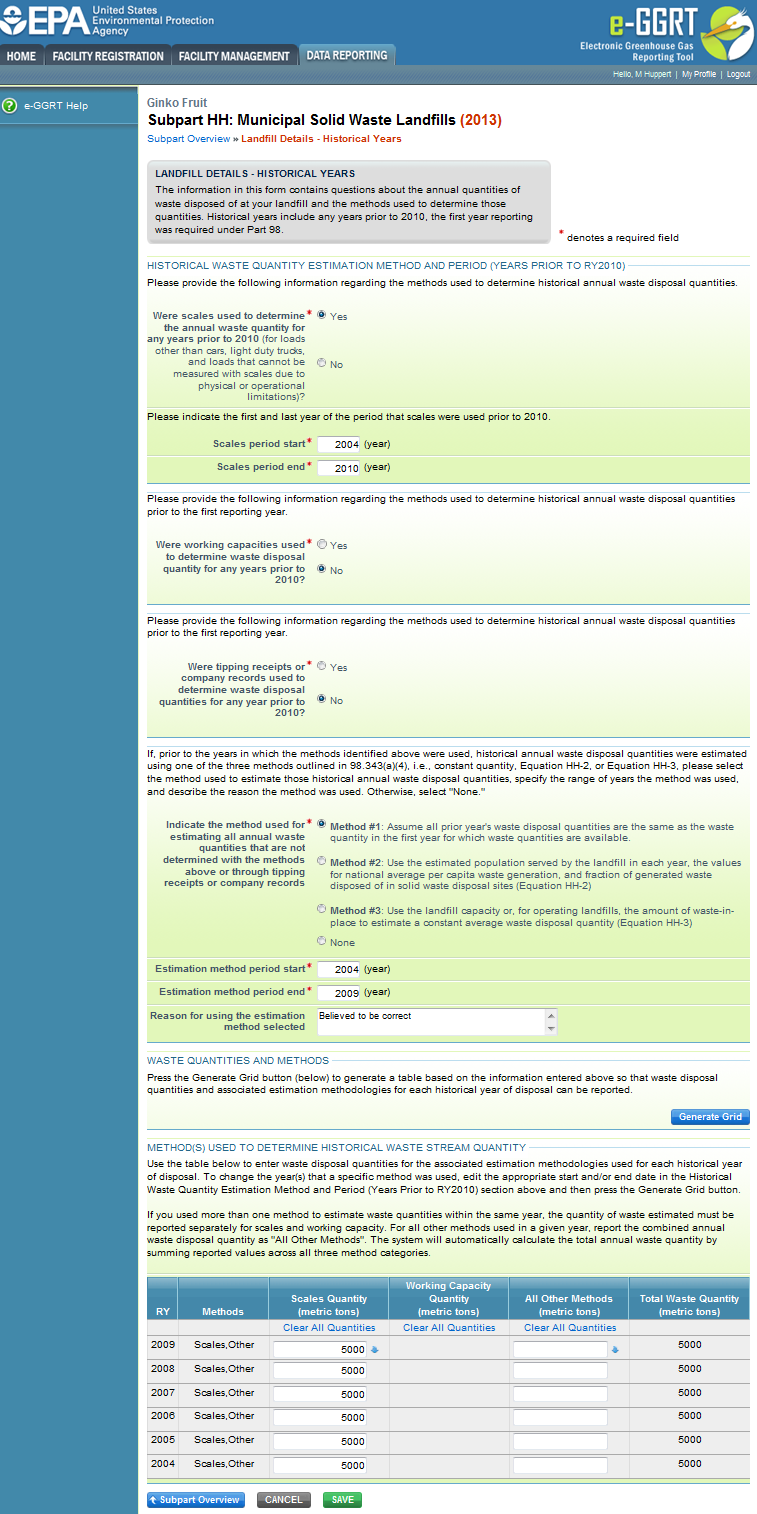 Image Added
Image Added
| Cloak |
|---|
| Wiki Markup |
|---|
{cloak:id=PNG3|| cloak.toggle.zone | true |
|---|
| id | PNG3 |
|---|
| | =none|cloak.toggle.zone=true}
| Panel |
|---|
 Image Removed Image Removed
|
- Method #2: Use the estimated population served by the landfill in each year, the values for national average per capita waste generation, and fraction of generated waste disposed of in solid waste dispoal disposal sites (Equation HH-2).
- If this method is selected, report the population served by the landfill for each year the Equation HH-2 of this subpart is applied.
...
{
:=} Click image this link to expand  Image Removed
Image Removed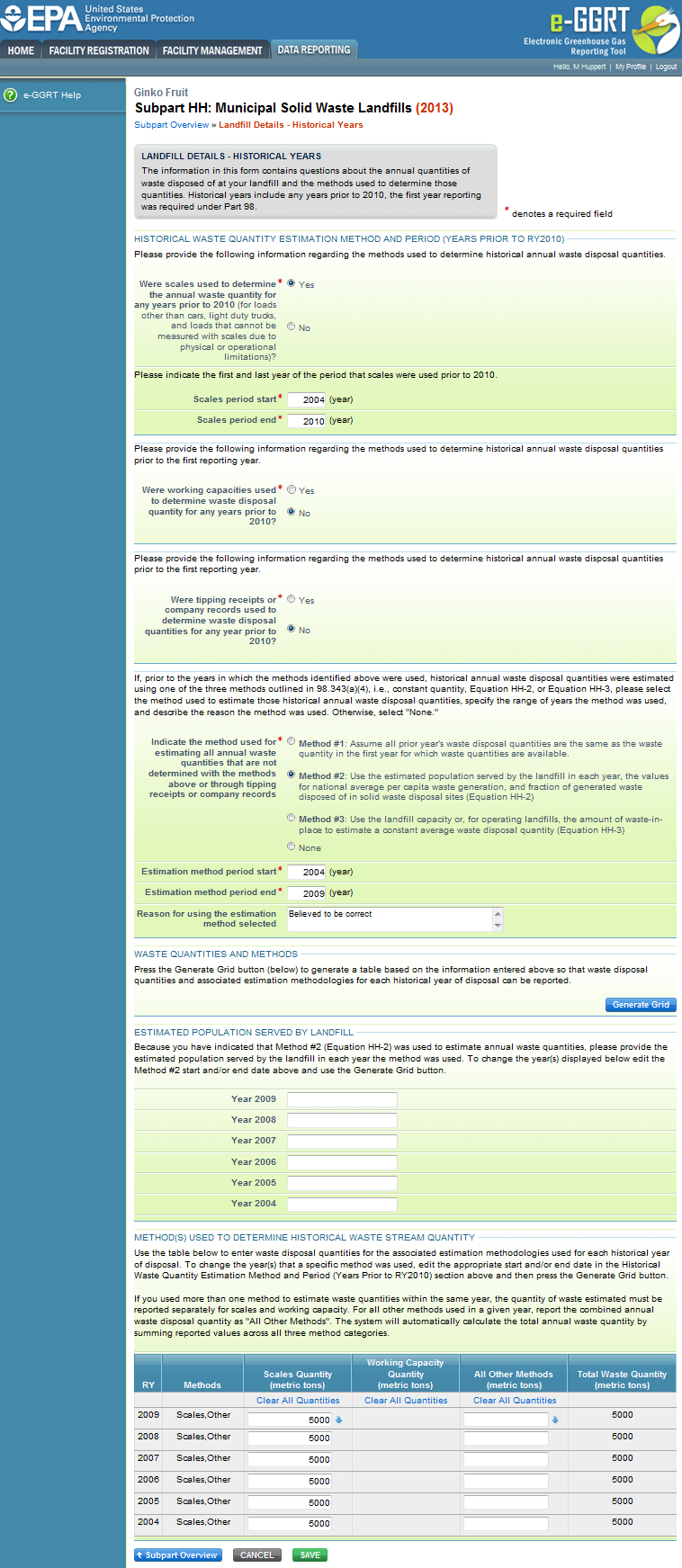 Image Added
Image Added
| Cloak |
|---|
| Wiki Markup |
|---|
{cloak:id=PNG4|| cloak.toggle.zone | true |
|---|
| id | PNG4 |
|---|
| | =none|cloak.toggle.zone=true}
| Panel |
|---|
 Image Removed Image Removed
|
Method #3: Use the landfill capacity or, for operating landfills, the amount of waste-in-place to estimate a constant average waste disposal quantity per Equation HH-3.
- The amount of waste-in place is the capacity of the landfill used at the end of the year prior to the year when waste disposal data are available. The waste-in-place numbers may be derived from design drawings or engineering estimates.
- If this method is selected to be the method by which historical waste disposal quantities were estimated, indicate the capacity of the landfill in metric tons.
| Wiki Markup |
|---|
{
:=} Click image this link to expand  Image Removed
Image Removed  Image Added
Image Added| Cloak |
|---|
| Wiki Markup |
|---|
{cloak:id=PNG5|cloak.toggle.type=none| | = | } |
panel |
 Image Removed Image Removed
|
If one of the above methods was used (i.e., “None” was not selected), indicate the year in which the method started being used and the year in which it stopped being used.
...
| PNG5 | | cloak.toggle.type | none |
|---|
|
| |
When you have entered the required information, click SAVE. You will be brought back to the top of the "Landfill Details - Historical Years" page at which time you may check over the information you entered. When you have completed your check, click SUBPART OVERVIEW to return to the Subpart Overview page.
#Back Back to Top
See Also
Screen Errors
Using e-GGRT to Prepare Your Subpart HH Report
Subpart HH Waste Characterization Information
Subpart HH Emissions Information
Subpart Validation Report














